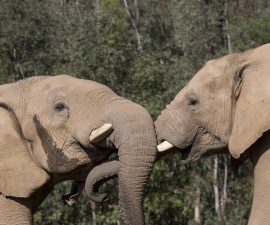When it comes to pollinators, most people think of bees, butterflies, and birds, gracefully flitting from flower to flower. But do you think about bats, mice, lemurs, and mongooses? Believe it or not, they’re also pollinators, and their ecosystems depend on them. In turn, we do too, as we share one planet and are all interconnected.
Whatever the species, pollinators all perform the same basic job—although their motivations and tactics may vary. In this symbiotic relationship, the pollinator moves pollen from the anthers (the male part) of one flower to the stigma (the female part) of another blossom. When the pollen sticks to the stigma, the flower becomes fertilized, enabling the plant to produce fruit and seeds. This is how plants are able to continue propagating and pollinators get a meal out of the deal. They may be attracted by a flower’s nectar, color, or scent, the prey hiding inside a plant, or the blooms’ mere availability, as in the case of ground-dwelling beetles that sometimes crawl in and pollinate low-hanging blossoms.
Flutter into this look at some of nature’s unexpected pollinators, how they help keep plants and the habitats they share healthy and thriving, and how we all rely on healthy ecosystems.
Mosquitoes

Although you may know mosquitoes mainly for feeding on, well, us, as well as other animals, they also feed on plant nectar. In fact, nectar is actually their primary food source! Feeding on nectar or plants doesn’t automatically make an animal a pollinator, but some subspecies of mosquitoes are. The snowpool mosquito Aedes communis and the Aedes aegypti mosquito are important pollinators of the blunt-leaf orchid Platanthera obtusata, which is found in woodlands, bogs, swamps, and other habitats across northern North America.
Chocolate Midges

Every chocolate lover owes a debt of gratitude to a tiny flying insect called the chocolate midge: the only known pollinator for the cacao tree Theobroma cacao, a native species in our Amazonia Conservation Hub. While they’re no bigger than the head of a pin, these efficient pollinators are skilled at navigating their way through intricate downward-hanging cacao flowers and distributing pollen along the way. Their successful efforts result in the tree producing cacao seed pods, which hold the stuff that chocolate dreams are made of.
Cape Spiny Mice

While many rodents are known to eat nectar-producing plants, South Africa’s Cape spiny mice, native to the Savanna, are delicate browsers, skilled at lapping up a flower’s nectar without eating or otherwise destroying the blossom. Their flowers of choice are the nectar-rich flora of the Protea family. Like other mammal pollinators, when spiny mice stick their faces inside a blossom to sip nectar, pollen sticks to their fur and gets transported to the next flower they visit.
Bats

More than 25 percent of all bat species eat fruit or plant nectar, including the Rodrigues flying fox. Bats pollinate flowers of many night-blooming plants, and are the main pollinators of agave. So, just as with chocolate, if you enjoy tequila or agave syrup you can thank an unexpected pollinator. Bats also serve as pollinators for mango, banana, and guava trees, but this isn’t the only way they help keep their native habitats flourishing. These mammals are prolific seed dispersers. When they eat fruit, the seeds are distributed in their poop so new plants can grow.
Sugar Gliders

They glide from tree to tree with the greatest of ease—and they’re pollinators, too. Sugar gliders are believed to be an important pollinator of native plants in the Australian Forest, including the cone-shaped flower clusters of Banksia species. These omnivores eat a lot of flowering plants and nectar, along with eucalyptus and acacia tree sap, carrying pollen on their bodies as they swoop through wide areas of Australian forests to find their next meal.
Kinkajous

Sometimes called “honey bears,” kinkajous are actually related to raccoons and coatis. And although they occasionally enjoy raiding beehives for honey, they spend more time eating flower nectar. In their Amazonia rainforest ecosystems, kinkajous are always on the lookout for nectar, roaming from flowering tree to flowering tree—especially balsa trees—to get another sweet sip and pollinating as they go.
Elephant Shrews

Cape Rock elephant shrews are surprising pollinators of the South African patent-leaf sugarbush Protea humiflora, a low-to-the ground species of Protea. This plant produces a very sweet, syrupy nectar that attracts a wide array of insects. But instead of being drawn by nectar, shrews search inside flowers for bugs to eat. Their long trunk-like noses, which give the elephant shrew its name, unintentionally pick up pollen from each flower, carrying it to other blossoms while searching for their next invertebrate meal.
Mongooses

Insects aren’t the only ones drawn to these plants’ sweet nectar. Although they’re carnivores, Cape gray mongooses are attracted to South Africa’s sugarbush and Protea plants by the nectars’ high sugar content. As they seek out the sugary liquid, they carry pollen along on their snouts from flower to flower.
Lemurs

Native only to Madagascar, there are more than 100 species of lemurs throughout this island’s forests, and about 10 percent of them are pollinators. Many lemurs eat nectar, and those that pollinate have long tongues enabling them to reach into flowers without damaging them, along with narrow snouts that pollen sticks to. Ruffed lemurs—including red ruffed lemurs and black-and-white ruffed lemurs—also have fluffy rings of fur on their necks that give them their name. These features help them effectively collect and transport even more pollen between flowers. Like bats, lemurs also eat large quantities of fruit and disperse seeds throughout forests as they forage. These unique primates are critical gardeners of their forest homes, fostering new plant growth by both seeding and pollinating.

Aye-Ayes
This particular lemur has a few interesting adaptations not seen in other subspecies. Aye-ayes are nocturnal and forage for food—including plant nectar, fruit, fungus, nuts, and insects—for most of the night. Their extra-long middle fingers are used to tap on trees and find insects, and their hands also help them pollinate. One of their favorite sources of nectar is the traveler’s palm tree. It takes strength to open the boat-shaped nectar structure below the traveler’s palm flowers, and the aye-ayes have it. Opening these pods not only offers access to nectar but ensures the traveler’s palm can produce seeds. This plant depends on aye-ayes and other lemurs that can reach the nectar structure and flowers to help it thrive.

Across the globe, more than 349,000 species are pollinators in their ecosystems. And thousands more, ranging from minuscule insects to majestic elephants, are seed dispersers, helping plants grow as they eat and move through their habitat. Each species has a part to play in maintaining healthy and biodiverse ecosystems, which is why when wildlife thrives, all life thrives.
As an ally for wildlife, you make our collaborative conservation efforts possible. Together, we’re saving, protecting, and caring for the world’s wildlife, big and small.
Top photo, bat pollinating: RebeccaBloomPhoto/iStock/Getty Images Plus





